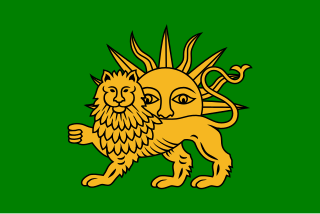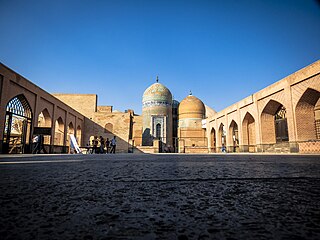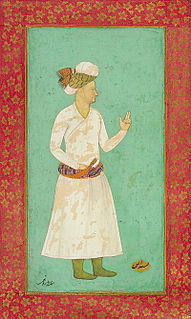
The Safavid dynasty was one of the most significant ruling dynasties of Iran from 1501 to 1736. The Safavid dynasty had its origin in the Safavid order of Sufism, which was established in the city of Ardabil in the Iranian Azerbaijan region. It was an Iranian dynasty of Kurdish origin, but during their rule they intermarried with Turkoman, Georgian, Circassian, and Pontic Greek dignitaries. From their base in Ardabil, the Safavids established control over parts of Greater Iran and reasserted the Iranian identity of the region, thus becoming the first native dynasty since the Sasanian Empire to establish a national state officially known as Iran.

Shahr-e Rey or simply Ray is the capital of Ray County in Tehran Province, Iran. Formerly a distinct city, it has now been absorbed into the metropolitan area of Greater Tehran as the 20th district of municipal Tehran, the capital city of the country.

Abbas the Great or Abbas I of Persia was the 5th Safavid Shah (king) of Iran, and is generally considered as one of the greatest rulers of Persian history and the Safavid dynasty. He was the third son of Shah Mohammad Khodabanda.

Ismail I, also known as Shah Ismail I, was the founder of the Safavid dynasty, ruling from 1501 to 23 May 1524 as Shah of Iran (Persia).

Azerbaijan or Azarbaijan, also known as Iranian Azerbaijan, is a historical region in northwestern Iran that borders Iraq, Turkey, the Nakhchivan Autonomous Republic, Armenia, and the Republic of Azerbaijan.
The Safavid order, also called the Safaviyya, was a tariqa founded by the Kurdish mystic Safi-ad-din Ardabili (1252–1334). It held a prominent place in the society and politics of northwestern Iran in the fourteenth and fifteenth centuries, but today it is best known for having given rise to the Safavid dynasty. While initially founded under the Shafi'i school of Sunni Islam, later adoptions of Shi'i concepts such as the notion of the Imamate by the children and grandchildren of Safi-ad-din Ardabili resulted in the order ultimately becoming associated with Twelverism.

Safi-ad-din Ardabili was a Kurdish poet, mystic, teacher and Sufi master. He was the son-in-law and spiritual heir of the Sufi master Zahed Gilani, whose order—the Zahediyeh—he reformed and renamed the Safaviyya, which he led from 1301 to 1334.

The Muslim conquest of Persia (637–651) led to the end of the Sasanian Empire and the eventual decline of the Zoroastrian religion in Iran (Persia). Islam has been the official religion of Iran since then, except for a short duration after the Mongol raids and establishment of Ilkhanate. Iran became an Islamic republic after the Islamic Revolution of 1979 which ended the Persian monarchy.
Qizilbash or Kizilbash, were a wide variety of mainly Turkoman Shia militant groups that flourished in Iranian Azerbaijan, Anatolia and Kurdistan from the late 15th century onwards, and contributed to the foundation of the Safavid dynasty of Iran.

Ahar is a city and capital of Ahar County, East Azerbaijan Province, Iran. According to the 2016 census, Ahar was the fourth most populated city of the province with a population of 100,641 in 20,844 families. Ahar was the capital of Karadag Khanate in 18th and 19th centuries.

Imāmzādeh Hamzah is an Imamzadeh mosque complex in Tabrīz, Iran. The mosque contains the grave of Hamzah, son of the Twelver Shī‘ah Imām, Mūsā' al-Kādhim.

Shaykh Haydar or Sheikh Haydar was the successor of his father as leader of the Safavid order from 1460-1488. Haydar maintained the policies and political ambitions initiated by his father. Under Sheikh Haydar, the order became crystallized as a political movement with an increasingly extremist heterodox Twelver Shi'i coloring and Haydar was viewed as a divine figure by his followers. Shaykh Haydar was responsible for instructing his followers to adopt the scarlet headgear of 12 gores commemorating The Twelve Imams, which led to them being designated by the Turkish term Qizilbash "Red Head".
The Safavid conversion of Iran to Shia Islam was a process that took place roughly over the 16th through 18th centuries and turned Iran (Persia), which previously had a Sunni majority, into the spiritual bastion of Shia Islam. It was a process that involved forced conversion and resulted in hostility with Iran's Sunni neighbours, particularly the Ottoman Empire. The conversion also ensured the dominance of the Twelver sect within Shiism over the Zaidiyyah and sects of Isma'ilism – each of whom had previously experienced their own eras of dominance within Shiism. Through their actions, the Safavids reunified Iran as an independent state in 1501 and established Twelver Shiism as the official religion of their empire, marking one of the most important turning points in the history of Islam.

Sheikh Safi al-Din Khānegāh and Shrine Ensemble is the tomb of Sheikh Safi-ad-din Ardabili located in Ardabil, Iran. In 2010, it was registered on the UNESCO World Heritage List. This monument is situated in the Ali-Ghapu area.

Ardabil is an ancient city in northwestern Iran, and the capital of Ardabil Province. As of the 2016 census, Ardabil's population was 529,374. The dominant majority in the city are ethnic Iranian Azerbaijanis and the primary language of the people is Azerbaijani.

Safavid Iran or Safavid Persia, also referred to as the Safavid Empire, was one of the greatest Iranian empires after the 7th-century Muslim conquest of Persia, ruled from 1501 to 1736 by the Safavid dynasty. It is often considered the beginning of modern Iranian history, as well as one of the gunpowder empires. The Safavid shahs established the Twelver school of Shia Islam as the official religion of the empire, marking one of the most important turning points in Muslim history.

Mirza Mohammad Taqi, better known as Saru Taqi was a eunuch of Safavid Empire, who served as the Grand Vizier of the Safavid king (shah) Safi and the latter's son Abbas II until he was assassinated on 11 October 1645.

Selim I , known as Selim the Grim or Selim the Resolute, was the Sultan of the Ottoman Empire from 1512 to 1520. Despite lasting only eight years, his reign is notable for the enormous expansion of the Empire, particularly his conquest between 1516 and 1517 of the entire Mamluk Sultanate of Egypt, which included all of the Levant, Hejaz, Tihamah, and Egypt itself. On the eve of his death in 1520, the Ottoman Empire spanned about 576,900 sq mi (1,494,000 km2), having grown by seventy percent during Selim's reign.
Ostad Ebrahim Banna Esfahani was an Iranian architect who flourished in 17th-century Safavid Iran. Born to Ostad Esmail Banna Esfahani, he hailed from Isfahan and in all likelihood descended from a family of distinguished craftsmen, for he and his father are referred to as "master" (ostād). His name is attested on two tiles; at the tomb of Abdussamad Esfahani in Natanz and at the Jameh Mosque of Isfahan. On both tiles, Ostad Ebrahim is referred to as the "builder from Isfahan".
Malikat Agha was a Mongol princess as well as one of the empresses of Shah Rukh, ruler of the Timurid Empire.
















